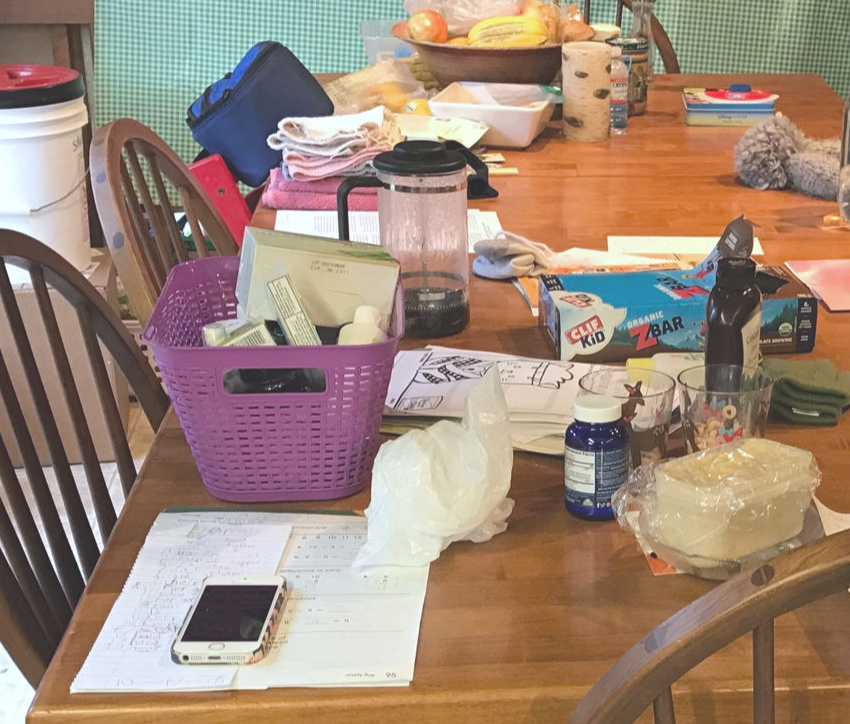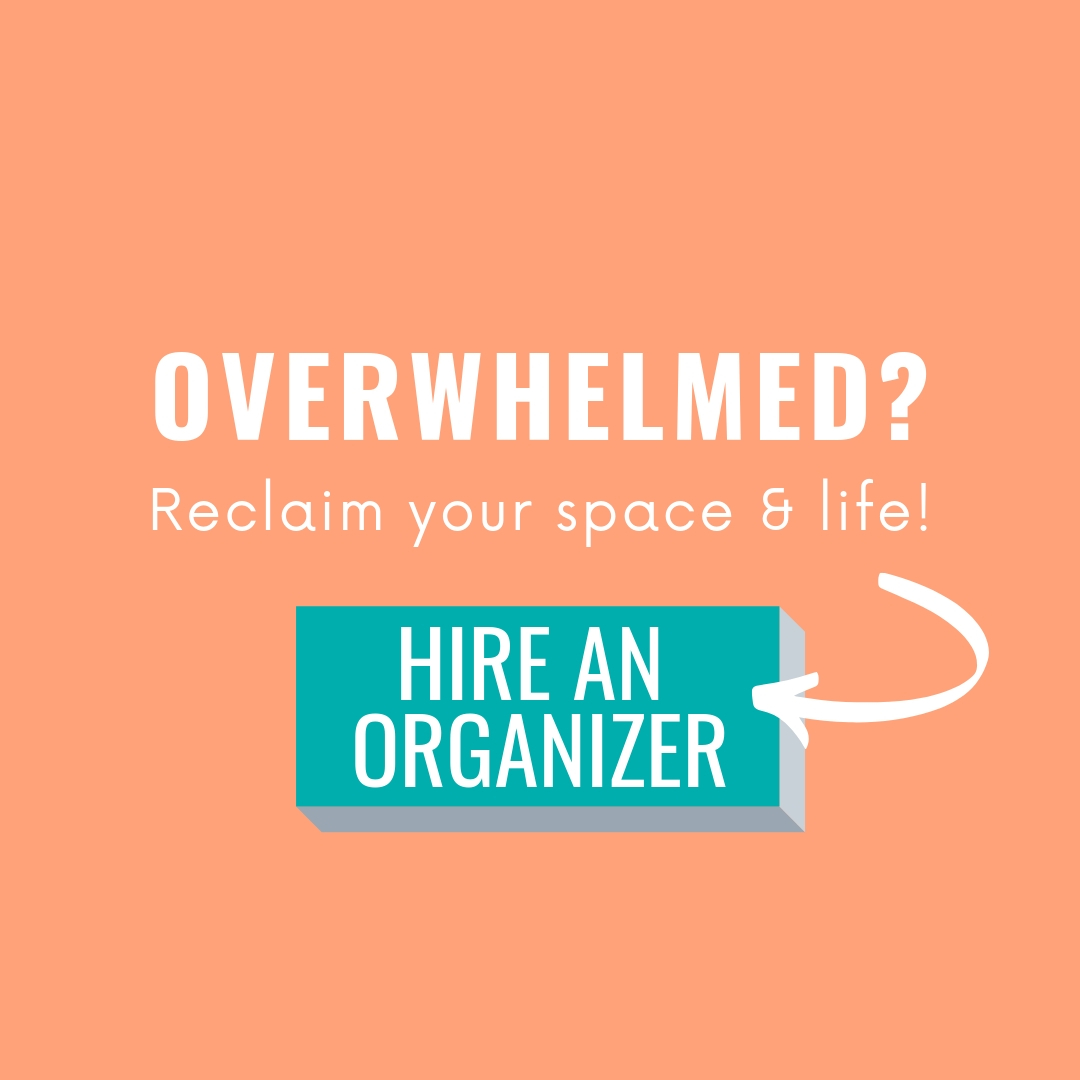
Ever wonder why your organized garage or desk doesn’t stay that way for long? Do the shoes piled in the entry NEXT to the shoe rack leave you scratching your head?
If you’re fed up with clutter and are ready to get rid of it for good, it’s time to take out your magnifying glass and discover the root cause of the problem!
Before you begin tidying up, STOP!
Your clutter actually holds valuable clues about WHY you are disorganized. The key to your organizing success is in deciphering these clues and addressing the root cause of your chaos.
I’m going to teach you about what things to look for in any environment to understand what is happening and how to fix it!

To illustrate this process, I’ll show you some cluttered spaces and how to become a detective to uncover the root cause of your disorder.
Take an aerial view
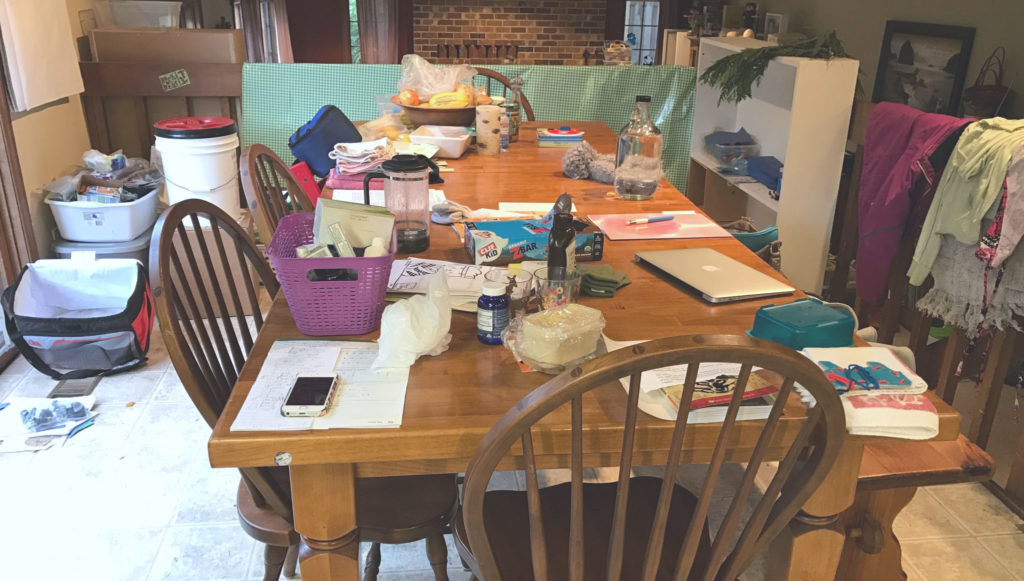
Here’s a dining table that may look all too familiar to many of us. These big, flat surfaces are a tempting spot to set things that we’re not sure what to do with or don’t have time to put away right then. Homeless items build up until the table can’t be used for it’s intended purpose any longer. We call this “surface abuse.”
This homeowner could take some time to put away the items collecting on her table and clear her surface. But, if done prior to understanding WHAT is landing here and WHY, I guarantee the table will fill right back up as soon as that precious surface space is visible again.
Ask the right questions
When people begin organizing a room, they sometimes make the mistake of walking into it with their blinders on. They ask HOW to put things away or WHAT containers to use.

They look at each room individually without comparing that space’s use to the other spaces’ uses.
Before creating organizing systems for a space, try to remove yourself from the space by taking an aerial view. Make observations about your space from an outsider’s perspective.
Begin to evaluate the items landing on your surfaces, and ask “WHY?”.
- Why did these items find their way here?
- Why is this particular location a clutter catcher?
It is very likely that it’s not just your dining table (or closet, or desk) that is the issue!

Taking an aerial view of your home allows you to observe adjacent spaces and consider flow. Instead of tackling an organizing project in a vacuum, you can then purposefully create a home that supports YOU.
(I cover this topic in detail in my first book.)
This table has a lot of kids’ items on it: homework, Cub Scout book and paperwork, craft items, worksheets. I also see cleaning rags, used cups and kitchen items, medicines, and food.
The next step – before nagging the kids to put away their things – is to go look at the places these items “should” be.
- Is there a homework station in this home? If not, this would be a great project that could solve the problem of surface abuse. Perhaps the kitchen table is the location for completing homework. If so, a system adjacent to the kitchen table where kids can easily put away their homework in time for dinner is needed.
- Where is medicine stored? Perhaps the bathroom or kitchen cabinet needs a refresh so these item are easier to put away.
- Cleaning rags – where does this homeowner keep her cleaning supplies? Does she need a system in a linen closet or under her sink to capture these items and spare her kitchen table?
Do you see how taking an aerial view of your home will help you actually SOLVE the problem of surface abuse? It’s not enough to just clear the space! You must get to the root cause of the problem, and establish systems for those nomadic items to enjoy lasting order.
Examine natural habits
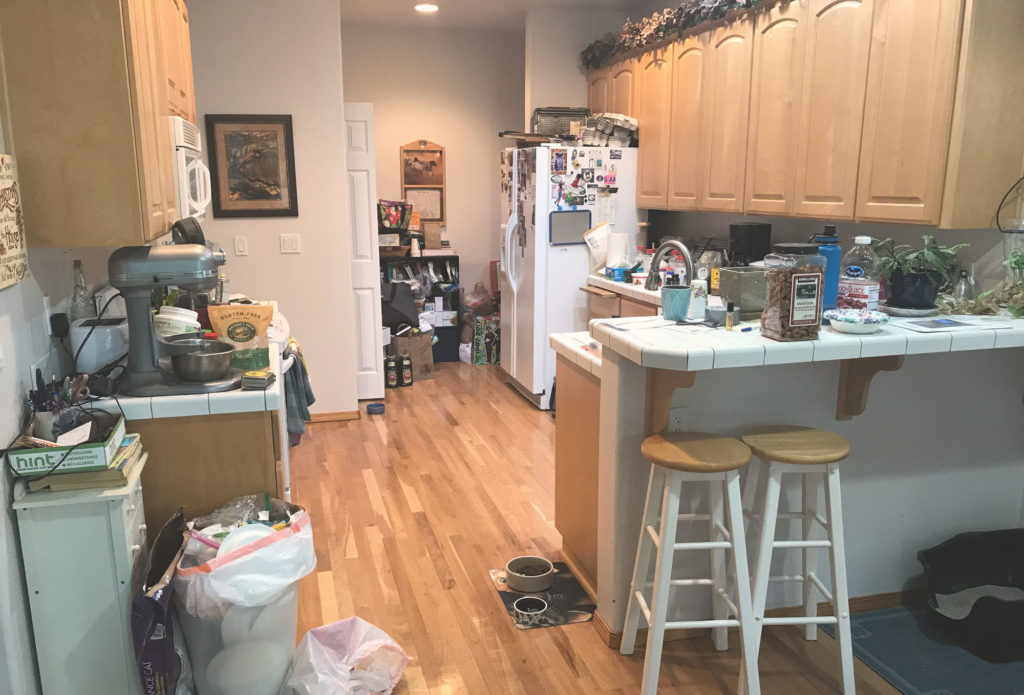
This overloaded kitchen is evidence of what I call “hit and run.” Items are brought out to use or set down after shopping, and the family runs on to the next thing without returning these items to their homes.
Now, as we discussed in the prior section, it’s helpful to take an aerial view and see WHY things are being left out on the counters. In this kitchen, the problem was that the homeowner simply had too much stuff, making it difficult to put things away. (See the full story and amazing before and after of this kitchen here.)
Once that is addressed, we look at habits next. Organizing starts with becoming an expert in yourself and observing your habits.
Break bad habits
Poor habits are often a main culprit of disorder. But, instead of beating ourselves up for our transgressions, it’s much more helpful to try to first understand our habits and then incorporate them, when possible, into our organizing plan.
Some habits I observe in this kitchen are:
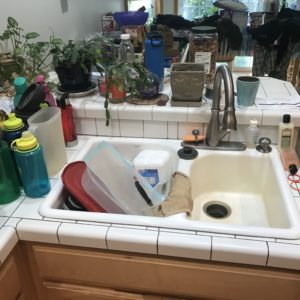
- Leaving the trash bag on the floor rather than taking it immediately to the outside trash bin
- Food left on the counter instead of stored back in the pantry
- Items used for preparing food left on the counters
- Dirty dishes left in the sink
After clearing out the cabinets and pantry and establishing good organizing systems, these homeowners must then retrain themselves with new habits in the kitchen including:
- Buying less
- Maintaining order in their cabinets and pantry
- Putting things away
Living an organized life includes daily choices that create and maintain order. We ultimately have to make a choice to put things away. We then must make that choice consistently until it becomes a new habit.
Remember: Good HABITS maintain order, not good intentions!
Evaluate user needs
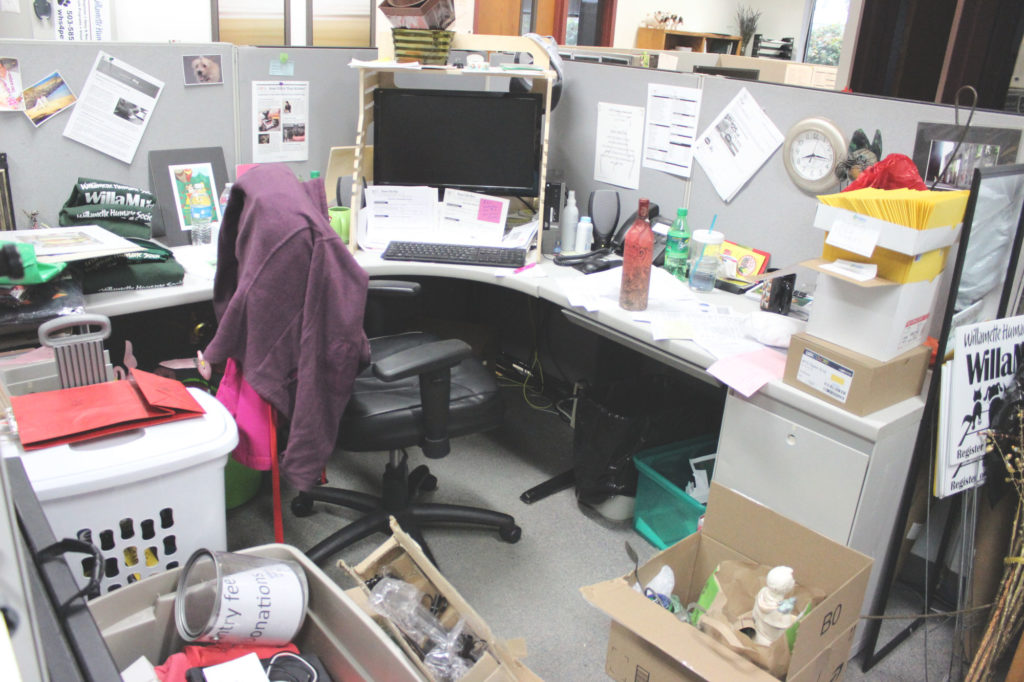
Another way to discover the root cause of disorder is to understand the unique needs of the user(s) of a space. In this picture we observe a lot of paperwork on the desk. There is also paperwork tacked to her cubicle walls, propped in front of her monitor, and stacked in boxes on her desk.
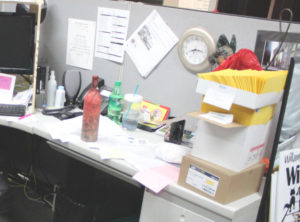
These observations are all clues about the STYLE of this worker. The woman who uses this cubicle is intensely visual. Tucking things away wouldn’t solve the organizing problem because all “current” work will find its way back onto her surfaces.
As you can see, good organizing honors the way each user is wired.
It’s fun to look at pretty, containerized organizing systems and to assume (or hope) they will work for everyone. Unfortunately, organizing is not a one-size-fits-all endeavor.
Design systems around people
To maintain order, we must take the time to understand the person using the space and set up systems that SUPPORT their way of thinking.
Out-of-sight storage for a visual person will create the out of sight, out of mind effect, while desktop organizing systems may cause anxiety for someone who craves clear surfaces.
Tip: When organizing your space, take time to really get to know yourself, your style, and your needs.
Not sure where to start? Use your clutter as clues!
- If you have clean counters, but a kitchen bursting with 3, 4, 5 junk drawers, you may need effective “below ground” systems to hide your belongings.
- If you have a great drawer system for art supplies, but always have a surface covered in accoutrements, you most likely are visual and need eye-level organizing systems.
Understanding your unique style – and the styles of those sharing your spaces – will lead to personalized organizing systems that will be easy to use and maintain.
Determine emotional causes of disorder

Finally, be sure to investigate emotional causes of clutter with your detective lens.
Any good organizing process MUST consider the reasons WHY overage is piling up. Otherwise, decluttering efforts will be temporary.
In this garage we observe piles of items to be put away. Camping equipment, boxes and books. We also see a lot of food stored on pantry shelves. This could be an indicator that this family lacks a pantry. Or perhaps that their pantry needs to be organized.
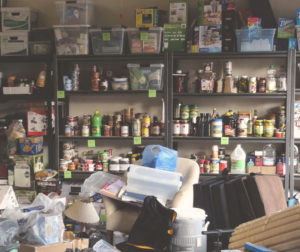
However, in this case, the homeowner has a fear of running out of food due to a childhood filled with hunger. Therefore, until that fear is resolved, food will continue to be acquired! Over-buying, then, is not a result of not knowing what is already owned, but over-buying is a result of fear.
Do you see how just “solving” the pantry problem won’t stop future buying and build up if there is an emotional issue at work here?
Clear emotional and spiritual clutter
When observing your clutter, get honest with yourself. Is there a hidden (or maybe not so hidden) emotional reason behind your buildup? Until that emotional root cause is addressed, the clutter problem will not go away – no matter how hard you try.
If you’ve attempted to get organized in the past and it hasn’t stuck, you may want to better understand the common causes of disorganization. I encourage you to read this blog that will walk you through reasons you are disorganized and how to solve the problem.

We hope these case studies have helped you pick up your magnifying glass and look for the root cause of your chaos. The truth is, most disorganized spaces have ALL of these factors are at play – overflow from other areas of the home, poor habits, misfit between organizing systems and the style of the person using them, and underlying emotional causes. If you attempt to get organized and the clutter reappears, get that magnifying glass out again and keep digging!
Getting to the root cause of your disorder and clearing out mental and spiritual clutter will lead to a life of lasting order. When you understand your space, your habits, your style, and yourself well you can design an environment that truly serves YOU!
Cheers to reclaiming your spaces and your life!
Related:
- Don’t miss a thing! Get our blog straight to your inbox by subscribing today
- For hands on help with getting organized, hire an order restorer
- Ready to reclaim your life? Take our online Life Reclaimist Series and take back your Household, Work, Health, and Spirit
- Subscribe to our YouTube channel for more organizing videos


